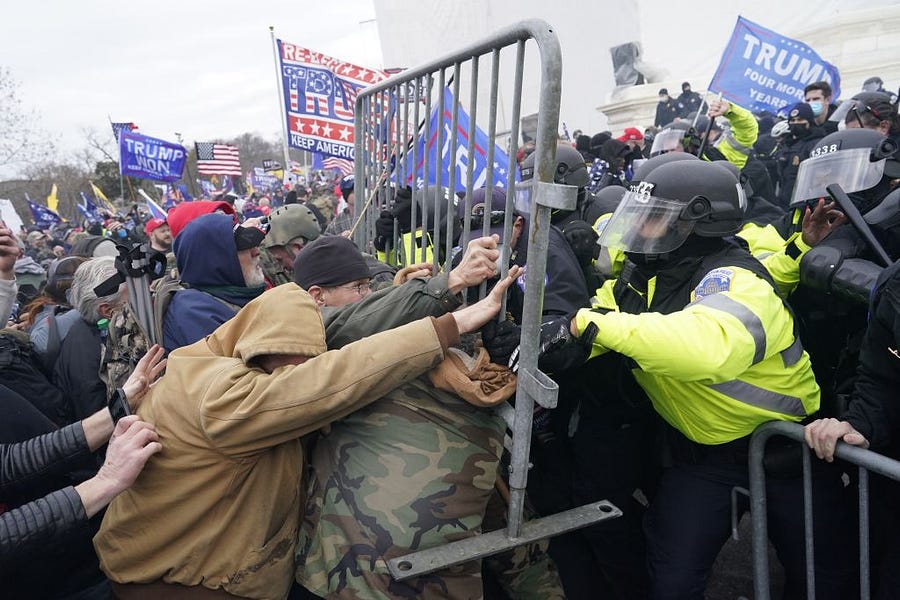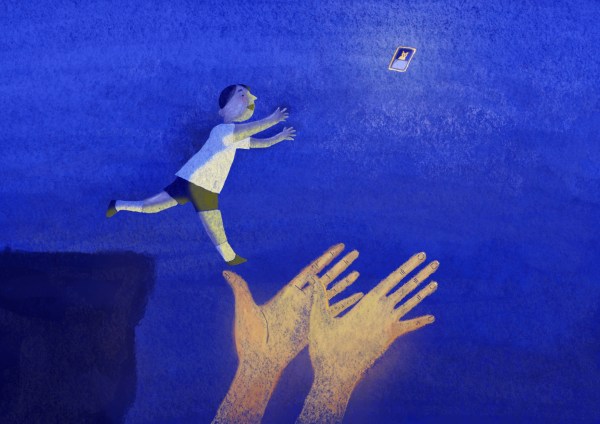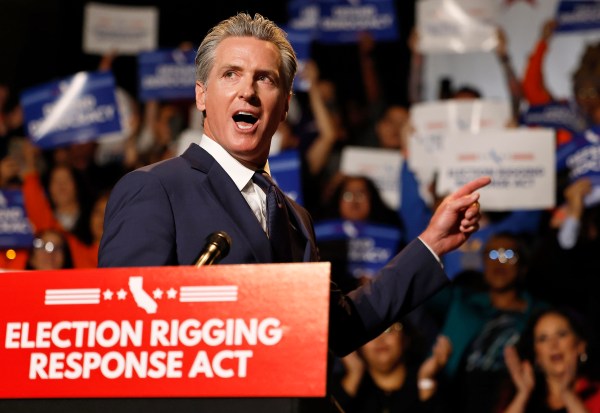In the wake of months of “Stop the Steal” rhetoric from Donald Trump and his allies, the January 6 assault on the U.S. Capitol was a sudden and shocking wake-up call for a GOP that had spent six months calling its opposition the party of political violence. So it was no surprise that new lies to blunt the cognitive pain began to spring up almost before the rioters had even left the building. False claims spread like fire across pro-Trump social media—and, later, across Fox News and even the U.S. House—that the real troublemakers had not been MAGA stalwarts, but Antifa interlopers. Such was the balm this narrative offered the Trumpian soul that even those who had stormed the Capitol themselves were repeating it in interviews with reporters by the following day.
The “It was Antifa” theory, based on blurry photos of misidentified tattoos and a Washington Times story that made quickly retracted claims about AI facial recognition, soon fell apart and was quietly abandoned by its most prominent proponents. Recently, however, a new narrative has begun to gain steam among the same crowd: the real ringleaders of the 1/6 violence may in fact have been undercover federal agents.
Here’s Tucker Carlson, host of the most-watched show on cable news, on Tuesday: “FBI operatives were organizing the attack on the Capitol, on January 6, according to government documents.” Here’s Rep. Marjorie Taylor Greene reacting to that segment on Twitter: “We need names and answers about the FBI operatives, who were involved in organizing and carrying out the Jan 6th Capitol riot.” And here’s Rep. Louie Gohmert making the same claim Thursday on the House floor: “We don’t like to see government agents stirring up trouble, or finding that there are criminal acts that would not likely have occurred had not the federal government been participating. … This is not only third-world stuff, this is like Putin kind of activity.”
It’s a remarkable charge: 1/6 was an inside job! You can see why Darren Beattie—the Revolver News writer behind the story, who appeared on Tucker’s show to discuss it—told the host, with an apparent lack of irony, that “I’m hearing from people that this is the most important and the darkest investigative piece they’ve seen in years.” One of those people is Beattie himself, who in the piece describes his own work as a “ground-breaking report” and a “seismic exposé.”
The only problem is that there isn’t any particular reason to believe it’s true.
The case built by Beattie (who, incidentally, is a former member of the Trump White House who was fired in 2018 for attending a conference with white nationalists) draws from various charging documents of some of the hundreds of people arrested for participating in the riot. (These are the “government documents” Carlson mentioned.) The case is predicated on a simple question: If the government is trying to throw the book at these rioters, why have some of the people described as participating in planning or coordinating the attack not been charged?
These mystery participants, known as “unindicted co-conspirators,” are common features of charging documents. When criminal activity is being described, involved actors whom the government has not yet charged are typically referred to anonymously. Criminal penalties aren’t the only undesirable outcomes of being associated with a crime: If they were named, people whom the government describes as committing crimes but don’t face charges would face major reputational damage while lacking the opportunity charged people have to try to clear their names in court.
There are several reasons why government officials might choose not to charge someone in this situation: They believe they have insufficient evidence to get a conviction, they don’t know for sure who the person in question is, or the person has agreed to cooperate with the government in exchange for charges being dropped. In this case, however, Beattie writes each of these possibilities off—judging it far more likely that at least some of the unindicted co-conspirators mentioned in charging documents were preexisting government informants, or even undercover agents.
From this assumption Beattie spins a tapestry of sinister possibility: If the FBI or other federal law enforcement had agents embedded within the groups that planned the Capitol attack, it suggests the government let the attack happen. It may even suggest that the government planted the seeds for the attack—in order, Beattie suggests, “to frame the entire MAGA movement as potential domestic terrorists.”
How to parse this theory? Well, one can start with the fact that there isn’t a shred of concrete evidence offered to support it. The closest Beattie gets is a few ominous inferences of similarities between the 1/6 attack and the months-earlier plot to kidnap Michigan Gov. Gretchen Whitmer, which the FBI broke up in advance thanks to undercover infiltration of the plan. Beattie points out that the then-director of the Detroit FBI Office later received a promotion and is now “the lead FBI agent for all 1/6 cases.” Beyond that, however, everything is couched in the language of pure hypothetical, with Beattie leaving it to the likes of Carlson, Gohmert, and Greene to make the jump into claiming these hypotheses as facts.
Even as hypotheticals, though, there are enormous problems with Beattie’s account. Many others have already pointed out that it would be highly unusual, if not impossible, for FBI agents or pre-embedded informants to be referred to as unindicted co-conspirators in charging documents—one Duke law professor told the Washington Post that “undercover officers and informants can’t be ‘co-conspirators’ for the purposes of establishing an agreement to violate the law, because they are only pretending to agree to do so.” Additionally, FBI informants are typically referred to in charging documents as “confidential human sources,” while undercover agents are referred to as “undercover employees.”
But the inside-job account falls apart at a still more fundamental level than this. In order to start layering on the hypotheticals and suspicions, Beattie first needs to establish that the existence of these unindicted co-conspirators in the charging documents is suspicious in the first place. He purports to do this by explaining why the usual reasons prosecutors would refer to people in this way supposedly don’t make sense here.
But when it comes to the likeliest reason prosecutors would refrain from indicting some participants—that some had agreed to cooperate with the government, testifying against their peers in exchange for leniency—Beattie’s explanation is simply absurd. Here’s how he frames it:
First, the timing doesn’t add up. The first indictment in the Oath Keepers case, already containing multiple key unindicted co-conspirators, was filed on January 27. The First Superseding Indictment was filed on February 19. The Second Superseding Indictment was filed on March 12. The Third Superseding Indictment was filed on March 31. But the first plea deal in the Oath Keepers case was not struck until April 16. This means that none of the unindicted co-conspirators in the first three months of filing could have gotten a grant of immunity.
To put it bluntly, this is not even close to how cooperation works. Beattie is arguing that none of the January 6 rioters could have flipped on their compatriots as early as January 27, because the first plea deal wasn’t filed in court until April 16. But April 16 isn’t the date the government reached an agreement with the person in question (Jon Schaffer, a founding member of the Oath Keepers militia)—it’s the date that agreement was entered into the court’s public record. By that point, Schaffer had already been cooperating with the government for an unknown amount of time.
The idea that a person can work backward from a public record of plea deals to ascertain which unindicted co-conspirators might or might not have been granted immunity is laughable. In some cases, the government may not strike an official plea agreement until after the co-conspirator has followed through on a pledge to testify. In others, the government may strike an agreement, but keep it under seal until the perp’s use as an informant has run its course.
“Once it’s announced that somebody has been charged, you’d have to be an idiot—mind you, there are stupid criminals—but you’d have to be an idiot to talk to these people about any ongoing criminal activity or to make any confession, because they’ve been charged,” John Malcolm, a former federal prosecutor and senior legal fellow at the Heritage Foundation, told The Dispatch. “But if it’s not known that somebody has been charged or that somebody’s entered a plea deal, then their value can continue.”
So assuming Beattie’s not simply a fool, what’s he really up to? This becomes clear elsewhere in his piece, where he attempts to draw a distinction between two groups of 1/6 offenders: the “mostly harmless tourists” and “MAGA moms” on one hand, who “walked through already opened doors and already-removed barricades, and at most were guilty of minor trespassing charges and light property offenses,” and on the other hand the group consisting of “those who were violent with police officers, broke down barricades, smashed windows, belonged to a ‘militia’ group engaged in military-style planning prior to the event, discussed transporting heavy weaponry, and so forth.”
The image Beattie is presenting is of a January 6 attack with MAGA elements scapegoated at every turn: militia elements entrapped into beginning the riot by federal agents, innocent sightseers wandering along for the ride. But of course that is not what happened. There’s no reason to believe federal agents incited the January 6 attack—the militia groups that have been charged were angry enough to do that on their own. And there’s no reason to believe the “MAGA moms” didn’t join the charge deliberately—they too were angry enough to do that on their own.
Who made them so violently angry? That’s the question Beattie and Co. are still trying to elude.






Please note that we at The Dispatch hold ourselves, our work, and our commenters to a higher standard than other places on the internet. We welcome comments that foster genuine debate or discussion—including comments critical of us or our work—but responses that include ad hominem attacks on fellow Dispatch members or are intended to stoke fear and anger may be moderated.
With your membership, you only have the ability to comment on The Morning Dispatch articles. Consider upgrading to join the conversation everywhere.